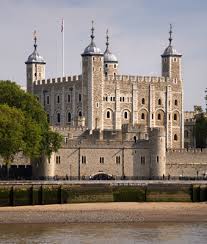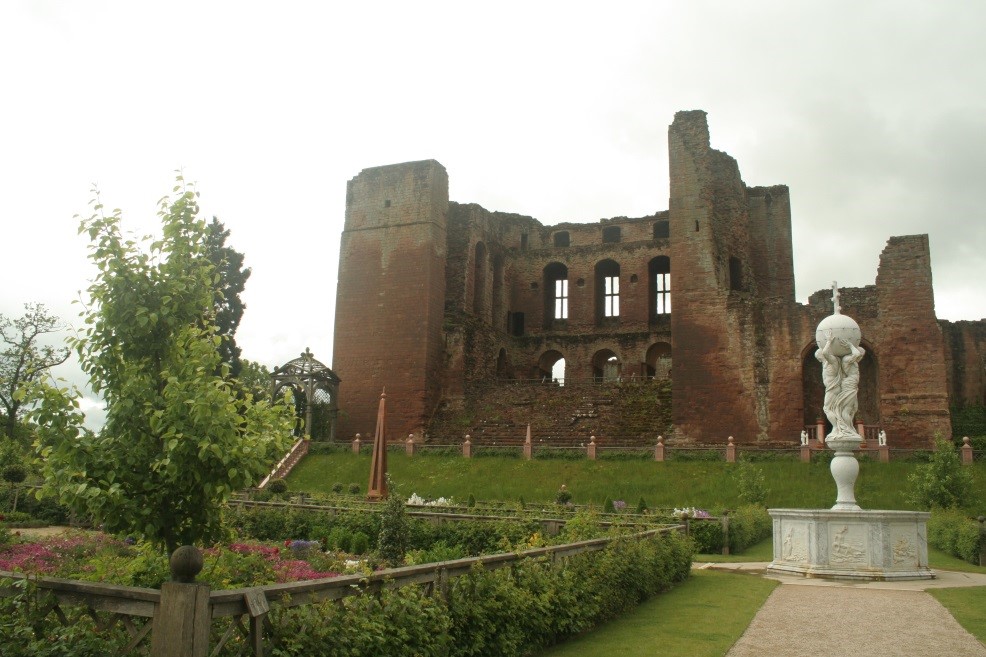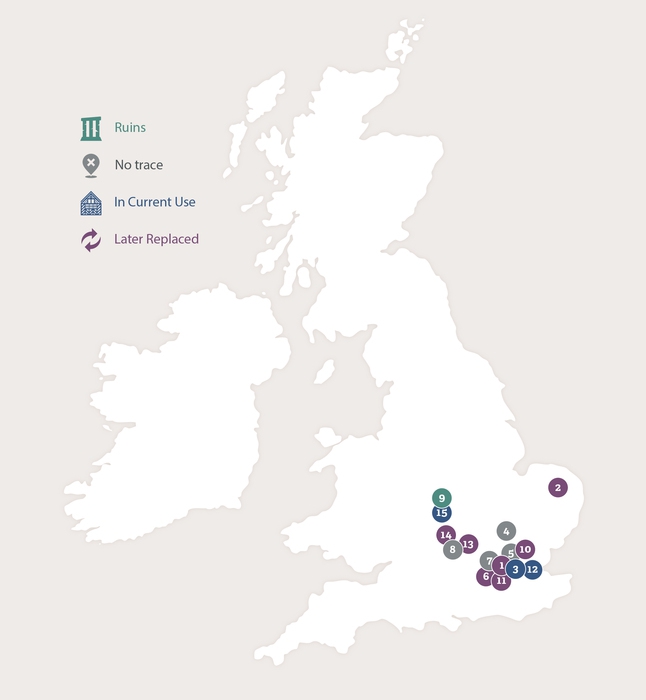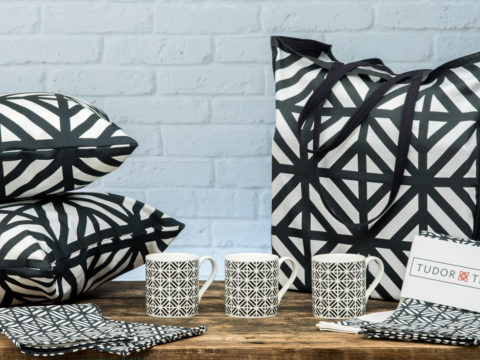Robert Dudley: From the Tower to Tilbury
Robert Dudley spent most of his life in and around the court, which was generally based in the south-east, but he dreamed of establishing a dynasty centred on Warwickshire, in homage to his distant Beauchamp ancestors.
The numbers against the places correspond to those on the map here and at the end of this article.
There is no record of where Robert was born, but he probably spent much of his youth at the various nursery palaces around London, as part of the entourage around Prince Edward. Later, when Edward became king, and Robert’s father achieved pre-eminence on the Council, the Dudleys' main London home was at Ely Place (1). Ely was once the London palace of the Bishops of Ely, and the crypt of the old palace is still extant, under later eighteenth century development. It was at Ely that Robert’s father arranged for his sons to learn the newly fashionable gentlemanly sport of [de]fencing, recently imported from Italy.
Robert first saw military service in July 1549, when he was probably aged sixteen. He was part of the force under his father, which was sent to Norfolk to quell Kett’s Rebellion. Kett was a local landowner, who had links to the Dudley family, leading to some suspicion that Robert’s father, then the Earl of Warwick, was in some way involved in the matter – aimed at unseating Protector Somerset. Nothing has been proved, and Warwick was effective in suppressing the rebellion, at the Battle of Mousehold Heath.
After the rebels had surrendered, Warwick and his sons visited Stanfield Hall (2), near Wymondham in Norfolk. Stanfield was the home of Sir John Robsart, and his wife Elizabeth, whose sister-in-law by an earlier marriage, was the wife of Kett’s brother.
Together, the Robsarts had a daughter, Amy, around the same age as Robert, who was the heir to the Robsart properties, the chief of which was Syderstone, although there was no house there, hence the family living in Stanfield. Stanfield was mediaeval in origin, and the house Amy knew remained in situ until the 1770s, when it was replaced by the current structure. It later became notorious as the location of the Stanfield Hall murders of 1848 – the owner, Isaac Jermy, and his son, were killed in the porch by one of their tenants, James Rush, who was later hanged at Norwich Castle. The execution was witnessed by over 12,000 people.
The Dudleys advanced under Edward VI – Warwick was granted the dukedom of Northumberland, giving Robert the courtesy title of ‘lord’. They even married into the royal family, with Robert’s younger brother, Guilford’s wedding to Lady Jane Grey, great-granddaughter of Henry VII. It was Northumberland’s attempt to put Lady Jane on the throne in 1553, after Edward VI’s death, excluding the rightful heir, Mary, that led to his downfall. Robert, who had taken part in the attempted coup, by attempting to capture Mary, was imprisoned in the Tower of London (3), along with his brothers. He remained there until 1555, under sentence of death, but housed in reasonable comfort in the Beauchamp Tower, and permitted visits from his wife (he had married Amy Robsart).

On Robert’s release from the Tower, he found favour with King Philip, the husband of Queen Mary, and titular King of England. He served with Philip in the French war of 1557-8, being present at the victory at St Quentin. This service was rewarded by an Act of Parliament, restoring Robert and his surviving brother, Ambrose, in blood, and removing the taint of treason.
Whilst Robert was no longer under threat of execution, he had no landed inheritance and was reliant in the late 1550s on his wife’s properties and income. Stanfield Hall had passed to Amy’s half-brother, so Robert and she had no fixed home of their own, but spent most of their time visiting relatives and friends, or renting property. Whilst the records are incomplete, it appears Amy often lived at Throcking (otherwise known as Hyde) Hall (4), near Buntingford in Hertfordshire. Little is known either about the owner (William Hyde) or the house, of which there is no trace.
Whilst Amy was at Throcking, Robert lived mainly in London, with his brother, Ambrose, who had been permitted to inherit their mother’s lands. Ambrose had a house near Christchurch (5), St Bartholomew-le-Grand, not far from Smithfield. There is no trace of the property now, but it would have been convenient for the court, a short river trip away at Whitehall, or down river to Greenwich.
As Queen Mary’s reign drew to a close, Robert was in contact with the heir to the throne, Elizabeth. He had known Elizabeth since childhood – as one of the boys surrounding her half-brother, Edward, she would have spent considerable time with him in the period 1540 – 1547, after which time she lived with her step-mother, Katherine Parr. Whilst no details are known of their early friendship, it was obviously deep rooted – shortly after her accession, Elizabeth mentioned that, whilst she was still under a cloud of suspicion in Mary’s reign, Robert had undertaken a land transaction on her behalf. He was certainly at her side within hours of her accession on 17th November 1558, and one of her first acts was to appoint him as Master of the Queen’s Horse.
Within weeks, Robert was inseparable from the queen. In his official role, he arranged the coronation, and rode behind her in the procession from the Tower of London (3) the day before. She also gave him a grant of land, which included a house at Kew (6). It is possible that it was a re-grant of property once owned by Robert’s grandmother, who was Baroness Lisle in her own right. It would have been confiscated from his father in 1553, but lands that were lost to the Crown following an attainder were often re-granted to heirs. There were other houses in the vicinity, owned by the various nobles of the Tudor court – Kew being a convenient distance from the great royal palace at Richmond, and another possibility is that Robert was granted the house later called the Dairy House. In the early sixteenth century, the Dairy House was owned by Henry Courtenay, Marquis of Exeter, and later transferred to Sir Miles Partridge, a follower of Protector Somerset. After Somerset’s execution in 1552, it was conveyed to Sir Henry Gate – but was back in Crown possession by 1559, and possibly then given to Robert. The current Kew Palace was built on top of the Dairy House, and traces of it are still visible in the lowest storey.
Another royal property which Robert used was Durham Place (7). Originally the London inn of the Bishops of Durham, it was located on the modern Strand, around about the current location of Shell Mex House at no. 80. It was probably originally built by Richard le Poor, in the 1200s. Over the centuries, it had frequently been used by the Crown to house guests, particularly when the Lord Chancellor was Bishop of Durham. During the early 1500s, Katharine of Aragon had resided there during her widowhood. In 1536, Bishop Tunstall resigned the property to Henry VIII, and Elizabeth was granted it after Henry’s death, for her town house. Notwithstanding its use by Elizabeth, Robert’s father took possession in early 1553. Apparently the princess ‘conceived some displeasure against him’ for his high-handed action. Durham House was the location for the marriage of Robert’s brother, Guilford, to Lady Jane Grey, and his sister Katherine to the Earl of Huntingdon. It was an impressive property, with a great hall, and over two acres of gardens. During the early 1560s, the house was used by the Spanish ambassador, but Robert and other members of his family frequently used it. There is a record of Robert and Elizabeth dining together there in March 1566.
With his almost permanent attachment to the court, finding a permanent home for his wife was not a priority for Robert and Amy was still spending her life at the homes of friends and relatives. By the middle of 1560, she was located at Cumnor Place, Berkshire (8). The property was originally owned by St Mary’s Abbey, Abingdon, and, following the dissolution, was occupied by the last abbot. By 1560, it was owned by William Owen, who leased it to Sir Anthony Forster. The Forsters had long been associates of the Dudleys, and Sir Anthony was Robert’s Steward. Forster had a reputation for honesty which did ‘much curb the evil thoughts of the people’, who might otherwise have suspected foul play. Despite the verdict of accident, Amy’s death cast a gloom over Cumnor, and it was said to haunted. The building was finally demolished in 1810, and stone from it was used in the construction of Wytham Church.
Robert’s dream of establishing himself as a major landowner in Warwickshire and the Midlands appeared to be closer to realisation in 1563, when Elizabeth conferred Kenilworth castle (9) on him. She had already restored Ambrose Dudley to the earldom of Warwick, and Robert’s ennoblement as Earl of Leicester occurred the following year. Robert spent some £60,000 on refurbishing the castle.

In 1577, Robert purchased a country house closer to London – the old royal hunting lodge, of Wanstead (10), which had been emparked in the early years of Henry VIII’s reign. Wanstead, now part of Greater London, was then in rural Essex, and the manor was in the possession of Robert Rich, who would later marry Robert’s step-daughter, Penelope Devereux. It was at Wanstead that Robert married Lettice Knollys, Dowager Countess of Essex, and the queen’s cousin. The couple often resided there, and it was the location of the death of their son, Robert, Lord Denbigh, at the age of three.
The property later came into the possession of George Villiers, Duke of Buckingham, then of Sir Henry Mildmay, one of the signatories of the death warrant of Charles I. The house that Robert lived in was demolished and replaced in the 1720s, which was in turn pulled down in 1825. Wanstead Park, in the London Borough of Redbridge, is all that remains of the manor.
Of course, a great nobleman also needed a London home, and Robert’s was at Leicester House (11), in the Strand. The property was built by Robert, and lay near Middle Temple. It was enormous, as befitted a man of Robert’s influence, with forty-two bedrooms, as well as a chapel, and gardens running down to the Thames. After Robert’s death, Lettice lived in it, along with her third husband, Sir Christopher Blount, and her son, the Earl of Essex. It became known as Essex House. The property was demolished in the 1670s.
The climax of Elizabeth’s reign came in 1588, with the defeat of the Spanish Armada. Robert, despite having been somewhat ineffectual as the queen’s lieutenant in the Netherlands, was appointed by her as Lieutenant-General of the English forces. The main encampment was at Tilbury (12), in Essex, ready to fend off any Spanish shipping that entered the Thames Estuary. Robert invited Elizabeth to review the troops, and he was at her side as she made her famous Tilbury speech, which proclaimed that she had ‘the heart and stomach of a king’. Afterwards, they dined together in his tent.
The visit to Tilbury was probably the last time Elizabeth saw her beloved ‘Eyes’ as she called him. Shortly after, he obtained leave to travel to Buxton for his health, in hope that the spa waters would restore him. He and Lettice set out from Wanstead (10) on 26th August 1588, planning to travel slowly via Oxfordshire, and presumably, Kenilworth. By 28th August, they had reached Rycote (13) a manor occupied by Sir Henry Norris, and his wife, who was one of Elizabeth’s closest friends (known to the queen as her ‘Crow'). Robert and Elizabeth had stayed there together in the past, and it was from Rycote that he dated his last letter to her. Rycote, probably built during the first half of the sixteenth century, had passed to Lady Norris from her father. Lady Norris was first cousin to the wife of Sir Anthony Forster, the owner of Cumnor Place (8). The house at Rycote has gone, but Rycote Chapel remains and is open to the public.
From Rycote, Robert moved on to Cornbury. This was another royal hunting lodge during the reign of Henry VIII. The Tudor building is no longer visible, major alterations having been carried out in the sixteenth and seventeenth centuries. The current house is in private hands, but open to the public. Robert died at Cornbury on 4th September 1588.
Robert emphasised his descent from the Beauchamp earls of Warwick by use of the crest of the bear and ragged staff, and his patronage of the old Beauchamp Chapel at St Mary’s, Warwick (15), and it was there that he chose to be buried. The Beauchamp Chapel is one of the best extant examples of a family chapel from the mediaeval period. The college of St Mary’s was founded in 1123, by Roger, Earl of Warwick, and the Beauchamp Chapel was constructed in the early fifteenth century by Richard Beauchamp, 13th Earl of Warwick, Robert’s 4 x great-grandfather. The chapel is open to the public.
The map below shows the location of the places associated with Robert Dudley discussed in this article.



